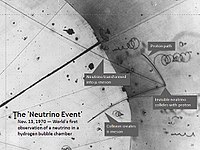
Photo from wikipedia
We study the formation and evolution of topological defects that arise in the postrecombination phase transition predicted by the gravitational neutrino mass model in Dvali and Funcke [Phys. Rev. D… Click to show full abstract
We study the formation and evolution of topological defects that arise in the postrecombination phase transition predicted by the gravitational neutrino mass model in Dvali and Funcke [Phys. Rev. D 93, 113002 (2016)PRVDAQ2470-001010.1103/PhysRevD.93.113002]. In the transition, global skyrmions, monopoles, strings, and domain walls form due to the spontaneous breaking of the neutrino flavor symmetry. These defects are unique in their softness and origin; as they appear at a very low energy scale, they only require standard model particle content, and they differ fundamentally depending on the Majorana or Dirac nature of the neutrinos. One of the observational signatures is the time dependence and space dependence of the neutrino mass matrix, which could be observable in future neutrino experiments. Already existing data rule out parts of the parameter space in the Majorana case. The detection of this effect could shed light onto the open question of the Dirac versus Majorana neutrino nature.
Journal Title: Physical review letters
Year Published: 2023
Link to full text (if available)
Share on Social Media: Sign Up to like & get
recommendations!